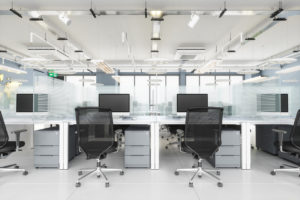What Does the Office of the Future Look Like?
Working together Means Making the Office Work for Each Other
The cheapest and most efficient way to do research on the office is to get out of the office. At least two things happen, sometimes without notice, when one escapes from the normal work routine. First, it becomes apparent how few pieces of hardware we actually need to get things done. And second, we actually get things done. With the “distractions” of the office removed and the cloak of relative anonymity leaves us with plenty of room for thought, suddenly the burden is lifted, clarity resumes and focus presides.
Why do we even need offices anymore, we wonder as we sip our cafe latte and chew on a croissant. Until an important client calls—via video—and any illusion of professionalism disappears. Then, after that call, a number of tasks must be accomplished and decisions have to be made via discussion and planning with a team of colleagues.
Yeah, we need to go back to the office.
The frequency of inspired bursts of productivity in the non-office environments of airport lounges, planes and trains, and cafes really makes one wonder what factors enable better focus in these seemingly stressful and cacophonous environments. And the question follows, how can we bring those catalysts back to the workplace?
Open Plan, Closed Communication

Somewhere along the line, we selected the wrong attributes associated with feelings of “escape” provided by working away from the old-fashioned office and applied them too liberally in workplace design. Opening doors, tearing down walls, moving management out of offices into an egalitarian “we all have the same size desk in an open room” office environment does not necessarily function well system-wide for every task.
Even if open-plan environments save on real estate and construction costs while also fostering a loft-party atmosphere, this style of interior design and its supposed enhancement of productivity, collaboration and transparency is failing us on many levels.
Some 70% of offices have open plan layouts, according to a 2010 survey of 424 facility management professionals by the International Facility Management Association. But despite the popularity of open offices, they have been associated with higher levels of employee dissatisfaction, stress, and illness.
A 2013 study published in the Journal of Environmental Psychology (http://www.sciencedirect.com/science/article/pii/S0272494413000340) found that workers frustrated by distractions in an open-plan environment exhibited poorer work performance. Nearly half of the surveyed workers in open offices said the lack of sound privacy was a significant problem for them and more than 30 percent complained about the lack of visual privacy.
A lack of privacy is accompanied by problems with noise. The reason people feel exposed when they speak is because sounds reverberate too easily in trendy offices with high ceilings, concrete floors, exposed-brick walls, and all the accoutrements of modern office chic. As a result, more than two-thirds of U.S. employees are unhappy with noise levels at work, and 53% say other people disturb them when they try to focus, according to a 2013 survey by global design firm Gensler (http://www.gensler.com/news/press-releases/gensler-releases-2013-u-s-workplace-survey-finds-only-1-in-4).
The same Gensler study also seems to disprove the notion that open office plans foster more collaboration. Those shy to speak for lack of privacy are less likely to interact with employees in face to face interactions. The numbers showed that people reported dedicating more of their time to “focus work” than they did five years earlier, estimating 54% up from 48% of previous workday allocation, and less collaboration, which they reported only occupied 24% of their time versus the 30% they estimated five years prior.
If that’s the general consensus, it’s no wonder the average person feels more productive when outside the office. And it’s not just true on an individual level. If you’ve ever decided to take a team meeting outside the office because you either didn’t have a place to convene or you needed an atmosphere more conducive to thought and collaboration, then you can probably relate to this data.
Options for Optimization
It probably doesn’t take a lot of research to assume that employees who feel that taking a phone call or crunching on potato chips is seen as a criminal disruption when sharing the same office. then the subsequent self-consciousness can lead to fatigue, burnout and even anti-social behavior. Gone are the days of chit-chat to break up the monotony of work, or worse, here are the days when the chit-chat of one brave extrovert rattles the concentration of an entire office.
Don’t throw out all your open-plan blueprints yet, though. There are compromises and enhancements that can be implemented in retrofits or new construction. Guidance begins with a Harvard Business Review workplace study from 2011 (https://hbr.org/2011/07/who-moved-my-cube), which found that, “The most effective spaces bring people together and remove barriers while also providing sufficient privacy that people don’t fear being overheard or interrupted. In addition, they reinforce permission to convene and speak freely.”
To move forward with building the office of the future, adding some creature comforts that support the individual while enabling group collaboration is key. Options must be presented for quiet, “head-down” work and also bustling, vibrant and loud group conversations.
In order to do this, it might be a good idea to take a little bit of inspiration from some unlikely places: the airport, the cafe and the gym. It’s time for some new ideas about the workplace of the future that synthesize individual comfort with team productivity.
Five Things That Could Heal the Open Office
Closed Collaboration Areas

Enter the huddle room. A small space with a door that closes, a table and a couple of chairs, and technology for videoconferencing or screen-sharing can produce even better results than a jolt of coffee. These private spaces are also used by individuals who seek a little quiet and separation from the crowd, maybe to make a phone call or just zoom into a task… a fact which should lead designers to consider making even smaller, individual nooks available, too.
There are a number of ways in which huddle rooms can be integrated into an office space. Some offices are creating “neighborhoods,” with open layouts mixed in with meeting rooms of various sizes. Ideally these neighborhoods are off the beaten path in the office, and allow for minimal interruptions from passersby.
Quiet Zones
Looking at that Gensler study again, noise truly is an issue. More than half of those surveyed reported being disturbed by others when trying to focus, and related to that, only one in four employees said their office environment fostered both collaboration and individual concentration.
It seems rather parental in nature, but some companies are imposing hours of restricted noise on specific days of the week. The idea is that everyone puts their thinking caps on and gets to work. That likely wouldn’t work at a corporate law firm, but it might work in some places.
More feasible options include designated seating areas where speaking is off limits. Many companies are adding “libraries” or cozy living room spaces to the office setup, adding a bit of softness and comfort as an option for deep thought.
Meanwhile, it helps to also designate areas for quick, easy collaboration and conversation. Clusters of unassigned desks might be set aside for these spontaneous meetups.
Private Offices
It is essential to acknowledge the one factor that has not changed with the advent of new technologies and methods of collaboration. Human beings are still
individuals, and individuals still need comfort and a little bit of privacy now and then.
A rise in cultural awareness around different personality types and the working styles of introverts versus those of extroverts is causing a shift in which visual exposure as well as acoustical agitation is making the notion of “hoteling” or any shared workspace a bit unreasonable. For introverts, and even extroverts, a little bit of privacy and seclusion through a private office can go a long way.
Given the option to switch between public and private selves, and use a bit of seclusion in separate rooms to focus on work instead of worrying about keeping up appearances, increases productivity. The psychological comfort of people who must share a workspace is more than just a warm-fuzzy. Increasingly, the need to not be visually on display or overheard is one that companies are looking to accommodate with the return of the four-walled offices that have been much maligned in recent decades.
Walls provide more than just visual seclusion. They also provide something we didn’t know we’d miss when we embraced open-plan offices—acoustical control. Walls do a lot to contain sound, block noise and break up the reverberation of everything audible in a space. Ever thought you would go insane because someone was stapling papers way too loudly? That’s likely due to an absence of walls or any other source of acoustical absorption to tone each metal clamp down a notch.
It’s not just annoyance we’re talking about here. Without walls, privacy is eliminated, creating tension within those who now have to whisper from fear of being overheard or disturbing others. Meanwhile, the disruption caused by carelessly loud talkers spreads endlessly throughout a space, breaking attention spans everywhere. This all adds up to psychological fatigue, and that takes away from productivity.
Add the Right Kind of Noise
So, what if you can’t build walls? Where walls aren’t possible, or where visual barriers exist without enough density to block sound from one work space to the next, it’s still possible to create seclusion. Acoustical privacy can be enhanced with the addition of absorptive materials and/or the implementation of a new, high-tech, digitally calibrated version of sound masking.
Lots of people know about “white noise machines,” and some loathe the sound they make. Rightly so, in some cases. Fortunately, and some serious progress has been made since those first airplane-esque noise generators were invented. Today the sonic signature of those devices is digitally calibrated to suit specific workspaces, often with multiple configurations throughout an office.
These invisible alterations to the environment may seem like hocus-pocus, but science is on our side here, and today’s advanced sound masking offerings have been measured and proven to increase comfort and productivity. This scientifically calculated comfort option softens the edges of noise and conversation levels in areas where it is employed. The effect is largely an unconscious one, but in offices where masking is in use, it feels easier to speak at a normal volume without feeling self-conscious about being overheard or resented for creating a disruption.
Habitats a la Carte
The open-plan office has one major detriment in common with the outdated cube farms they replaced. They’re too uniform. Rows of desks, and only rows of desks, installed between more rows of desks, while economical for the employer, are just not an appealing or sustainable option for real human interactivity and psychological needs.
Ultimately, the key to healing the open office layout is to offer a combination of work spaces fostering a variety of types of productivity. Whether casual or formal, open or closed, silent or energetic, each workspace has a purpose. Allowing individuals to select based on their preference will garner much productivity. Given the chance to roam, it might be startling to see how often members of a team stay put, and work for the group as individuals.
Even if the idea of hanging up photos and calling a cubicle your home is out of style, there are still ways to personalize the workplace. The open-office healing begins with a closer look at how team members really work. Where do they go when they meet, and why do they go there? What do they need when it’s time for focused, individual work? Are there options for private meetings or phone calls? A real analysis will prompt many more questions, so don’t expect just one answer. There is no one workplace for everyone. Fortunately, there are a lot more solutions for making one space work differently for many.
Learn more about Lencore on our website or see our open office applications and case studies here.

The Impact of Remote Work on Productivity and Innovation
A recent study found the shift to remote work has hindered communication and collaboration amongst groups within the company, threatening individual productivity and innovation. The study also found that remote work has altered the way employees communicate,

Increase Patient Satisfaction and Comfort
From Small to Large Healthcare Facilities where a quiet environment ensures better rest and recovery, and protecting the privacy of patient information is the law, Lencore Sound Masking helps create a balanced, comfortable environment that’s not too

Dante Interface
Lencore Streamlines Inclusion of Dante in System Designs We’re pleased to announce that our i.Net solution is now compatible with Dante – the most widely used audio-over-IP solution in the world. With a simple adapter this integration
